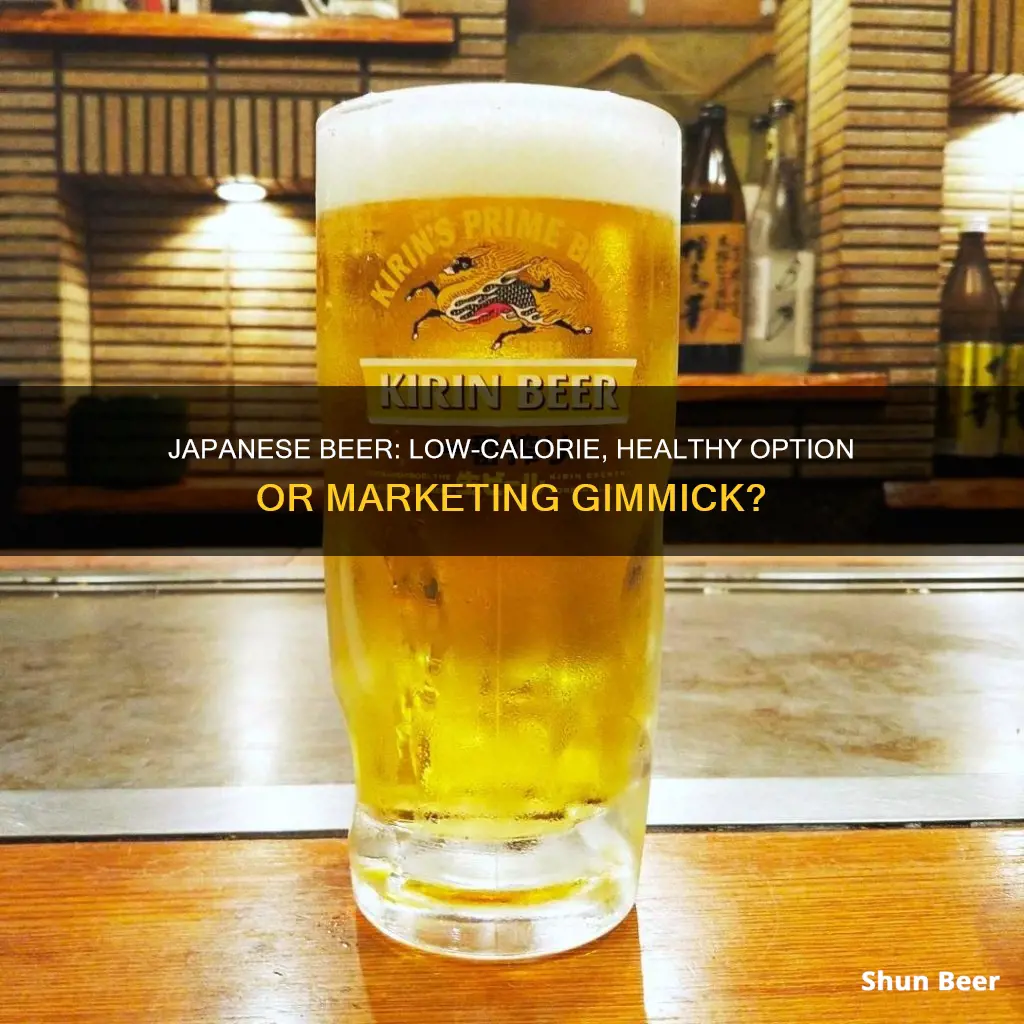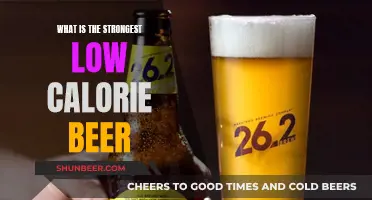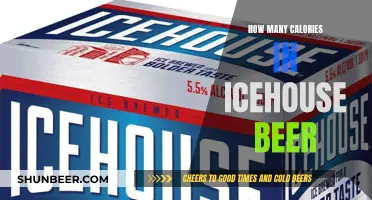
Japanese beer lovers have been concerned about the sugar content and calories in beer, and want to drink more without the added sugar. In response, major beer companies have started producing low-carb beer to get back sales and support their customers' health. These low-calorie beers are often marketed towards women and health-conscious consumers. Some popular low-calorie Japanese beers include Kirin, Suntory All-Free, and Asahi Dry Zero Free.
| Characteristics | Values |
|---|---|
| Calories | Low |
| Malt content | Less than 2/3 (67%) |
| Price | 141 yen per 350ml can |
| Taste | Lighter |
| Alcohol content | 3% |
What You'll Learn
- Japanese beer brands Asahi, Kirin, and Suntory offer low-calorie options
- Happoshu is a low-calorie, beer-like beverage
- Low-calorie alcoholic drinks are popular among people who have gained weight
- Low-calorie alcoholic drinks are also popular among health-conscious drinkers
- Low-calorie alcoholic drinks can be expensive

Japanese beer brands Asahi, Kirin, and Suntory offer low-calorie options
Asahi Super Dry, Japan's best-selling beer, has 131 calories per 330ml bottle. This is relatively low compared to other popular beers, and there is also a non-alcoholic Asahi beer with zero calories.
Kirin, Japan's oldest brewery, offers Kirin Light, a 3.2% light beer with 95 calories per bottle. Kirin Light is made with "the finest two-row barley malt and European noble hops" and is described as having a "surprisingly smooth and full-bodied taste".
Suntory, one of the newer Japanese beer companies, offers an alcohol-free and calorie-free option with its All-Free beer. All-Free is described as an "ultra-light, ultra-crisp, and ultra-refreshing" beer alternative. It has gained popularity in Japan since its launch in 2010 and is now widely available.
In addition to these options, there are also happoshu beverages, which are beer-like drinks with a malt content of less than 67%. Happoshu is often marketed as a low-calorie, healthy alternative to beer and is popular among young people and women for its lighter taste.
Calories in Beer: Understanding the Count in Your 20oz Pint
You may want to see also

Happoshu is a low-calorie, beer-like beverage
Happoshu is a Japanese alcoholic drink that is brewed in a similar way to beer but has a lower malt content—67% or less. It is often referred to as a "low-malt beer" in other countries. The lower malt content means that happoshu is taxed at a lower rate than beer in Japan, making it a cheaper option for consumers.
The taste of happoshu is lighter than that of beer, and it is often marketed as a low-calorie, healthy alternative. Some young people and women in Japan prefer happoshu for its lighter taste. However, it has a stigma as a low-quality beverage due to its lower price and different name from beer.
In addition to happoshu, there are other beer-like beverages in Japan that are even cheaper, such as "the third beer" or "daisan-no-biiru". These drinks use malt alternatives or are a mix of happoshu and another type of alcohol.
While happoshu is a popular choice for those looking for a low-calorie alcoholic drink, some people find the taste less satisfying compared to beer. Ultimately, the decision between drinking beer or happoshu depends on individual preferences, budget, and the volume of alcohol consumption.
One example of a low-calorie happoshu is Kirin's light beer, which has just 19 calories per 100 ml and zero carbs. This product was developed in response to consumer demand for healthier alcoholic options and took three years to create.
Calories in Bengali Tiger Beer: All You Need to Know
You may want to see also

Low-calorie alcoholic drinks are popular among people who have gained weight
Low-Calorie Alcoholic Drinks: A Weight-Loss Companion?
Alcohol is often associated with weight gain, but some drinks are better than others if you're watching your weight. While Japanese beer may not be the lowest-calorie option, there are plenty of alternatives that can help you cut down on calories without compromising on taste.
Japanese Beer: Not the Lightest Choice
Beer was introduced to Japan in the late 1800s, and today, the country boasts four major breweries: Kirin, Asahi, Suntory, and Sapporo. While Japanese beers are known for their light and pale taste, they may not be the best choice if you're counting calories. A standard 12-ounce bottle of beer typically contains around 153 calories.
However, there is a beer-like alternative called "happoshu," which has gained popularity among those looking for a low-calorie option. Happoshu has a malt content of less than 2/3, compared to beer's higher malt content, and is often marketed as a healthier choice. Kirin, a major Japanese brewery, even released a light beer with just 19 calories per 100 ml and zero carbs, catering to health-conscious consumers.
Low-Calorie Alcoholic Drinks: A Weight Watcher's Friend
If you're looking to cut down on calories without giving up alcohol entirely, here are some popular choices:
- Vodka Soda: A classic combination of vodka and unflavored club soda, this drink typically contains around 133-142 calories per serving. You can add a spritz of lemon or lime juice or garnish it with cucumber or mint for extra flavor.
- Rum and Diet Cola: Instead of regular cola, opt for diet soda to reduce calories and sugar intake. Rum itself contains about 97 calories per 1.5 fluid ounces and has no carbs or fat, making it a good choice for weight-conscious drinkers.
- Gin and Diet Tonic: By swapping regular tonic water for diet tonic water, you can significantly reduce the calorie content of this classic cocktail. A gin and diet tonic made with 2 ounces of gin and 4 ounces of diet tonic water provides approximately 129 calories.
- Light Beer: Light beers typically have about 50 fewer calories than their regular counterparts, making them a good option if you're a beer lover watching your weight. A 12-ounce bottle of light beer usually contains around 100-103 calories.
- Martini: A classic martini is made with gin and vermouth and garnished with olives or lemon wedges. For a low-calorie twist, opt for a dry martini, which has more gin and less vermouth. A dry martini with 2.5 ounces of gin and 0.5 ounces of vermouth contains approximately 185 calories.
- Tequila and Lime: A shot of tequila with a lime wedge is not only easy to make but also very low in calories, totaling only about 99 calories. If you prefer a cocktail, you can mix tequila with club soda, mint, or coconut water for a low-calorie option.
- Champagne and Sparkling Wine: These drinks can be a great low-calorie choice, especially if you opt for dry varieties like brut champagne, which have lower sugar content. A 4-ounce serving of champagne typically contains 85 calories.
- White Wine: With approximately 148 calories per 180 mL, white wine can be a good option for reducing calorie intake. You can also add fresh fruit or mix in some sparkling water or club soda for a refreshing spritzer.
- Hard Seltzer: Hard seltzers combine seltzer water with alcohol fermented from cane sugar and are usually available in fruity flavors. A 12-ounce serving typically contains around 99 calories, depending on the brand and flavor.
Tips for Mindful Drinking
When trying to lose weight, it's important to consume alcohol in moderation and choose drinks with minimal added sugar. Making your drinks at home allows you to control the ingredients and portion sizes, avoiding premade mixers high in sugar and calories. You can also experiment with low-calorie mixers, such as diet tonic water or sugar-free options, and enhance your drinks with fresh herbs like mint, rosemary, or basil instead of sugary syrups.
Calories in Oberon Beer: Nutritional Facts and More
You may want to see also

Low-calorie alcoholic drinks are also popular among health-conscious drinkers
Low-Calorie Alcoholic Drinks for Health-Conscious Drinkers
Beer
Beer is often associated with high calories and carbohydrates. However, there are low-calorie alternatives available, such as light beers, which have fewer calories and a lower alcohol content. In Japan, for example, Kirin offers a light beer with just 19 calories per 100ml and zero carbs, catering to health-conscious consumers. Another option is "happoshu", a beer-like beverage with a malt content of less than 2/3. Happoshu is often marketed as a low-calorie, healthy alternative to beer in Japan and is particularly popular among young people and women for its lighter taste.
Spirits and Mixers
When it comes to spirits, clear liquors like vodka, gin, and tequila are good low-calorie options. For example, a shot of tequila with lime has only 99 calories. Vodka soda is another popular choice, with about 65 calories per ounce of vodka. Gin and tonic can be made lower in calories by using diet tonic water instead of regular. Rum and Diet Coke is another classic combination with fewer calories than the regular version.
Hard Seltzers and Wine
Hard seltzers, which combine seltzer water with alcohol made from fermented cane sugar, are a refreshing and low-calorie alternative to cocktails, beers, and mixed drinks. White wine spritzers, made by mixing white wine with club soda, are another excellent option, with around 75 calories in a 5-ounce drink.
Beck's Beer Calorie Count: Nutritional Facts for Health-Conscious Drinkers
You may want to see also

Low-calorie alcoholic drinks can be expensive
Low-calorie alcoholic drinks are often more expensive than their full-calorie counterparts. This is due in part to the cost of the ingredients used and the production process. Additionally, the demand for low-calorie alcoholic beverages is relatively high, which can drive up prices.
The Cost of Ingredients
One reason for the high cost of low-calorie alcoholic drinks is the cost of the ingredients used. For example, malt, which is used in beer, is a more expensive ingredient than the corn, soy beans, and starch used in happoshu, a low-calorie Japanese beer alternative.
Production Costs
The production process for low-calorie alcoholic drinks can also be more costly. For instance, Kirin, a major Japanese brewery, spent three years developing its light beer, which contains just 19 calories per 100 ml and zero carbs. This lengthy development process adds to the overall cost of the product.
High Demand
The demand for low-calorie alcoholic drinks is relatively high, especially among those who are health-conscious or trying to lose weight. This demand can drive up prices, as producers know that consumers are willing to pay more for these products.
Alternative Options
However, there are some ways to enjoy low-calorie alcoholic drinks without breaking the bank. For example, hard seltzers are a relatively low-calorie option, and there are several brands that offer lower-calorie counts, such as Two Days and Served. Additionally, opting for straight spirits, such as vodka or whiskey, will give you the lowest number of calories per ounce, and you can mix them with low-sugar options like soda water or diet tonic.
Calories in Beer: Understanding the Pitcher's Worth
You may want to see also
Frequently asked questions
There are low-calorie Japanese beer options available, such as happoshu, a beer-like beverage with less than 67% malt content, and "new category" beers, which are low-calorie and low-carb.
Some low-calorie Japanese beers include Kirin's light beer, which has 19 calories per 100ml, and Suntory's All-Free, which has zero calories.
Yes, there are non-alcoholic and low-calorie Japanese beer options, such as Asahi Dry Zero Free and Suntory All-Free.
Low-calorie Japanese beers have gained popularity due to consumer demand for healthier alcoholic beverages and as an alternative to high-calorie options like whiskey high-balls and shochu cocktails.
Low-calorie Japanese beers are available for purchase at convenience stores in Japan and online through websites like Amazon.







